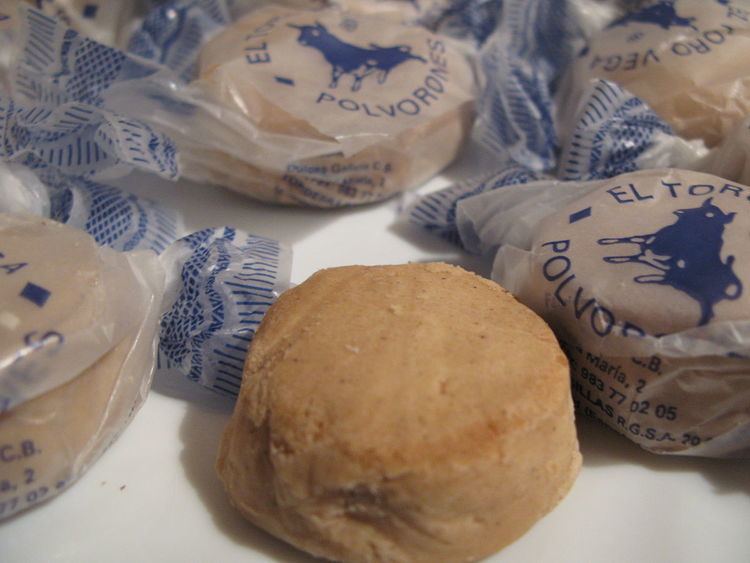 | ||
The gastronomy of the province of Valladolid comprises the meals, their preparation, and the culinary habits of the province of Valladolid. Of all the cuisines of the community of Castile and León, it is the most common. it is based on barbecued and roast food, especially roasted Spanish cuisine. Wines of high quality highlight the meals.
Contents
Cereals
A large amount and variety of cereals: (wheat, maize, barley, rye) are grown locally and form the basis of high-quality breads. The animal husbandry of the province is also capable of producing some outstanding cheese, such as the "queso of Villalon" (cheese of Villalon) (similar to Burgos cheese).
Vegetables
Between the cookeds is the cooked Spanish (with "ball" to which is added for flavoring Spearmint ), the "sopa de chícharos" (or guisantes)(soup peas) which is prepared with peas (in Spanish pea means "guisante" or "chícharo"). The "coliflor al ajoarriero" (cauliflower in garlic). Between the legumes are dishes such as "alubias con patuño de cerdo" (beans with pork leg). Within the cereals are the pans and its derivatives as the " sopa de ajo" garlic soups, the "sopa de bestia cansada" (soup of beast tired) of Medina del Campo to be offered to the mules of the muleteers. It is an area of "ajoarrieros" (which means muledriversgarlic), for example "Ajo de Vallelado" (Garlic of Vallelado).
Meats
Meat and sausages are the products that have the most fame for their unique flavor. The province belongs to the area of Spanish-style barbecued roasts. Dishes include "lechazo asado" (roast veal or lamb), "cochinillo asado" (roast suckling pig), "cordero asado" roast lamb, "morcilla" (Blood sausage or Black pudding), "asados al sarmiento" (roasted meat with wine) a typical dish in Santibáñez de Valcorba and environs, "Chuletones de Buey" (a large steak of ox), with "ajillo" (garlic), typical in Peñafiel). The "embutido" (sausage) called "chitas" (cheetahs) is well known, being prepared with the meat of Suckling pig in adobo. Other pork-based sausage are the morcilla de Valladolid (black pudding from Valladolid spiced with a special kind of onion ), and the "salchichas" (sausages) from Zaratán. Chorizo is also used in dishes such as "tortilla de chorizo" (Chorizo omelette). For beef produces a "tojunto" (no translates), like the "tojunto of Castile" (influence of gastronomy of Aragon). Of the smaller game, there are preparations such as the "conejo a la cazadora" (rabbit to the hunter).
Seafood
Among the fish, like other Castilian provinces there are trout dishes, an example being the "truchas con jamón" (trout with ham).
Confectionery, desserts
The pastries of the province include specialities such as the "bolla de chicharrones" (Cake of pork rind), the "rosquillas de palo" (stick donuts), the "mariquitas" (ladybirds), the "roscados" (donuts), the "mantecados de Portillo", the "roscos de yema" (yolk roscos), the "rosquillas de trancalapuerta" (donuts of trancalapuerta), los "bizcochos de Santa Clara" of Tordesillas (Cakes of Saint Clara), the "hojuelas" (flakes), the "bizcochos de cura" (cakes of cure). Other generic dishes popular in the province include "arroz con leche" (rice pudding).
Special dishes
It is common during Holy Week to consume special food that is part of the Gastronomy of Holy Week (mainly desserts).
On September 8 in Valladolid during the celebration of the Virgin of San Lorenzo sweets, pastas, pastries and other desserts are usually served, one highlight being the "tarta de San Lorenzo" (pie of Saint Laurence).
On dates near Halloween and All Saints' Day (October 31 and November 1, respectively) it is very typical to consume products known as "Huesos de Santo" (saint's bones) and "buñuelos" (similar to fritter).
At Christmas, the Gastronomy of Christmas is very abundant and diverse, highlighting the dishes with abundant sweets, such as turrón, the polvorones of Tordesillas being the most famous, Date palm, marzipan, and Dragées. It is also usual eat typical dishes of dates, such as the suckling pig, chicken, turkey, capon, Lamb and mutton, bream, prawns (in addition to other seafoods). On 31 December (new year) it is a tradition to eat Twelve Grapes to the rhythm of the first twelve bells of the new year. In the early morning of 1 January "chocolate with churros" (Chocolate with Spanish doughnut) is often eaten, either at home with families or in a chocolatier, coffeehouse, or bar. On 6 January (Day of the Three Kings) it is usual to eat the traditional roscón de reyes (king cake).
Wines
Wines from the province of Valladolid are among the best in the world due to their outstanding taste and quality. Many of the most famous come from the Vega Sicilia winery. The province has five wines with a denomination of origin. Wines with a Rueda Denomination of Origin were court wines at the time of the Catholic Monarchs. They are produced from a range of verdejo grapes, and to a lesser measure from Sauvignon blanc cultivars. Under this appellation there are white, sparkling, red, pink and liquor wines. For their part, the wines of Ribera del Duero are elaborated with the ink on the country and you can taste red wines young, reserve wine and old vine. Wines of the Toro Designation of Origin are mainly white, rosé and red; the wines of Tierra de León Denomination of Origin are white, rosé and red and finally, there are the rosé wines of the Cigales denomination of Origin
